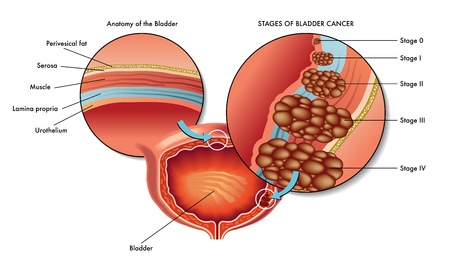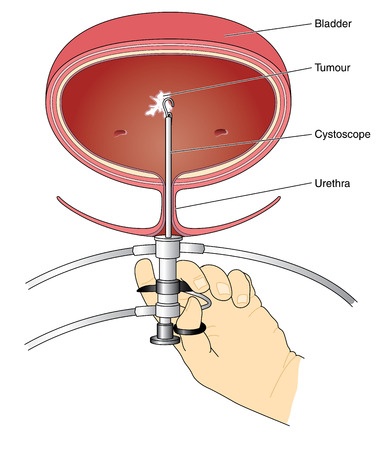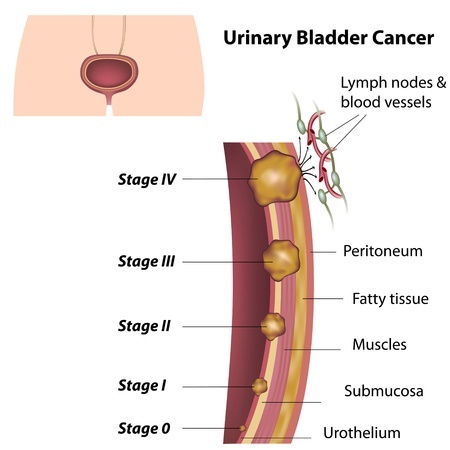Overview
Bladder cancer is a cancer that usually begins in the lining of the urinary bladder and involves the uncontrollable growth and increase of abnormal cells in the bladder.The urinary bladder is a hollow, balloon-shaped, muscular organ located in our pelvis. It functions mainly in the storage of urine and its disposal.

Symptoms
Bladder cancer typically causes hematuria or blood in the urine, which is painless. Urine may appear dark yellow, bright red, or cola-colored. But in most cases, urine appears normal and blood cannot be spotted by the naked eye, only under a microscope during routine urinalysis.Other symptoms, which are “irritative” and less common, are frequent urination, painful urination, back pain, and pelvic pain.
All of the mentioned symptoms are not specific to bladder cancer and can be brought about by non-cancerous conditions such as kidney stones and urinary tract infections. Therefore, it is very important to see a physician if experiencing any of these.
Risk Factors
Smoking increases the risk of having bladder cancer due to the harmful chemicals that are processed by the body and are later on accumulated in the urine, which irritate or damage the cells lining the bladder. Exposure to other certain chemicals used in dyes, leather, paint products, rubber, and textiles may also increase the risk of bladder cancer.Older people, whites, and men are more prone to having bladder cancer, although anybody can have it.
Genetics is also contributory to acquiring bladder cancer. If one or more among your immediate family members or relatives have a history of cancer, you become more prone to bladder cancer.
Chronic urinary tract infections can also predispose bladder cancer because of repeated bladder irritation.
Certain diabetic medications containing pioglitazone and previous cancer treatment using cyclophosphamide can also augment the risk of bladder cancer.
Diagnosis
Diagnosis of bladder cancer begins with a thorough physical examination and medical history taking by the doctor.
Certain diagnostic tests are initiated, such as cystoscopy, biopsy, urine cytology, and imaging tests. Cystoscopy permits the doctor to take a view inside the urethra and bladder using a narrow tube called a Cystoscope. Biopsy can be done during the cystoscopy procedure wherein the doctor obtains a cell sample from the urinary bladder lining for testing. Urine cytology is performed when a urine sample is analyzed for presence of cancer cells. Imaging the urinary tract is also done by intravenous pyelogram and CT scan.
Once bladder cancer is verified, additional tests (bone scan, chest x-ray, CT scan, and/or MRI) may be ordered by the doctor in order to stage the cancer.
The stages of bladder cancer are the following:
- Stage I: Cancer is limited at the bladder’s inner lining.
- Stage II: Cancer has attacked the muscular bladder wall but is confined to the bladder.
- Stage III: Cancer has extended to surrounding tissues, prostate in men and uterus or vagina in women.
- Stage IV: Cancer has reached the lymph nodes and other organs.

Treatment
Treating bladder cancer always depends on various factors: cancer stage, general health, and treatment preferences. Treatment options include surgical interventions, immunotherapy or biological therapy, chemotherapy, and radiation therapy.Surgery is performed to get rid of the extent of the cancer; it may involve removing the tumor only, the tumor and a part of the bladder, or the whole bladder and creating another way for urine to exit the body.
Immunotherapy or biological therapy helps the immune system to fight cancer cells using drugs such as Bacille Calmette-Guerin (an immune-stimulating bacterium) and interferon (a synthetic immune system protein). It is given directly to the urinary bladder through the urethra.
Chemotherapy makes use of drugs used to kill cancer cells.
Radiation therapy, however, is seldom used in bladder cancer. It is usually done in tandem with chemotherapy to kill cancer cells.











